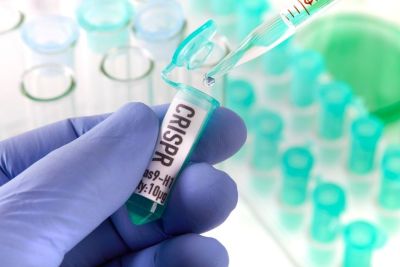Making the Cut with CRISPR

At the 2020 Nobel Prize announcements, the prize in chemistry was awarded to Emmanuelle Charpentier and Jennifer A. Doudna for their work developing a genome editing tool called CRISPR—a tool that Widener students are not only learning about, but are getting hands-on experience using in undergraduate research projects.
CRISPR, the “genetic scissors” of genome editing technology, can be applied in a variety of ways to manipulate genes to affect various cellular behaviors.
“CRISPR projects work by asking about how a particular gene functions in a system, and what happens if we cut that gene out,” Fran Weaver, professor of biology and biochemistry, explained.
Jenna Jacoby, a junior biology major, is getting a firsthand look at how CRISPRs function in her research project with Weaver, studying the metabolism of chickens. This research has ramifications not only for commercial poultry production, but also for how our food supply might be affected by climate change.
“The chickens we eat are heavily bred for the sole purpose of us eating them,” Weaver explained, “so they grow fast, put on weight quickly, and are not especially tolerant to heat stress as they experience living in huge commercial barns. As the weather gets hotter in certain parts of the country, those chickens in commercial production facilities are going to be more stressed by the heat, so we’d like to figure out a way to either get chickens to be less stressed by the heat – by introducing some gene that would allow them to be more heat-tolerant – or by killing off the function of something that might make them less heat tolerant.”
Jacoby is currently researching chicken metabolism and figuring out how she can use CRISPR to edit a particular gene related to heat stress. This semester, she’s been developing single-stranded DNA guides that will later be used to target specific genes with CRISPR to test hypotheses using laboratory-grown cells.
Jacoby plans on getting a master’s degree in reproductive medicine or developmental biology before heading to medical school. She knows this research experience will look great on her future applications, but she’s also fascinated with the learning she’s doing now.
“It’s really interesting to investigate a ‘why.’ Asking why something happens and not just describing what is happening,” she said. “I’m excited to see how this all works out, how we figure out what specific genes to target and then asking the why about the production and function of those cells in the chickens.”
“It’s important that our students have access to the latest and greatest cutting-edge research activities,” Weaver said. “One of the wonderful things about doing CRISPR is, it’s relatively inexpensive and very much accessible to students, but you have to have faculty members who are engaged in pursuing these types of projects.
“It’s a really great research opportunity for students to take the basic science knowledge and technical skills they already have and apply them to the type of research people out in the field are doing. Jenna’s been able to do that and develop her skills, but she also came in with some pretty good skills so she was able to hit the ground running in the lab just based on the coursework she’s already done,” Weaver said.
CRISPR & Fruit Fly Fat
CRISPR research also has significant implications for studying and potentially curing genetic diseases. Michael Toneff, assistant professor of biology, and junior biochemistry student Morgan Grace are interested in how fat formation in fruit flies could have ramifications for curing type-two diabetes in humans.
“We’re looking at how we can use CRISPR to target the Zw gene in fruit flies, which controls their fat formation and functions in a similar pathway that humans have,” Grace said. “And then we can look at fat formation and relate that to diabetes.”
Obesity is on the rise in the United States, and risk for type-2 diabetes increases exponentially with an increased BMI. If Toneff and Grace’s research with fruit flies is successful though, they may find a way to regulate fat production, and therefore BMI rate, in humans using CRISPR.
Grace has been a fan of CRISPR ever since she saw a TED Talk on the subject, so she’s thrilled to be working with the technology as an undergraduate.
“I personally have always loved CRISPR,” Grace said. “I think it’s the coolest thing ever and that’s why I wanted to do this research so badly. Now I’m doing this amazing work with Dr. Toneff and Dr. Nagengast, who I love working with. It’s just perfect.”
Grace is looking forward to getting a laboratory job after she graduates and then deciding on a master’s program after she explores her options in the field. No matter what she does, Toneff said, this research project is putting her on the inside track in her career.
“This technology is in widespread use now so if students want to go to graduate school, having that experience and knowledge puts them a step ahead. Students going to med school also benefit from exposure to CRISPR technology because of the many health benefits potentially available based on this research,” Toneff said.
“We read one of the Nobel-winning papers on CRISPRs in my classes and it’s pretty hardcore molecular biology, so I think whatever students want to do with their careers, it teaches them a lot of logical and analytical thinking," he added.


